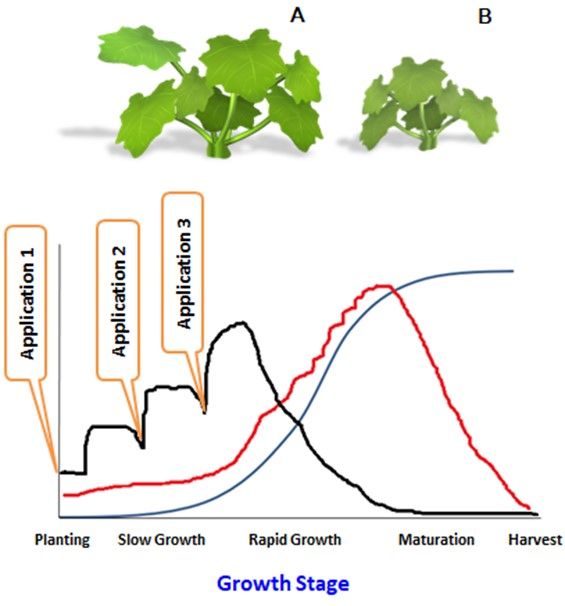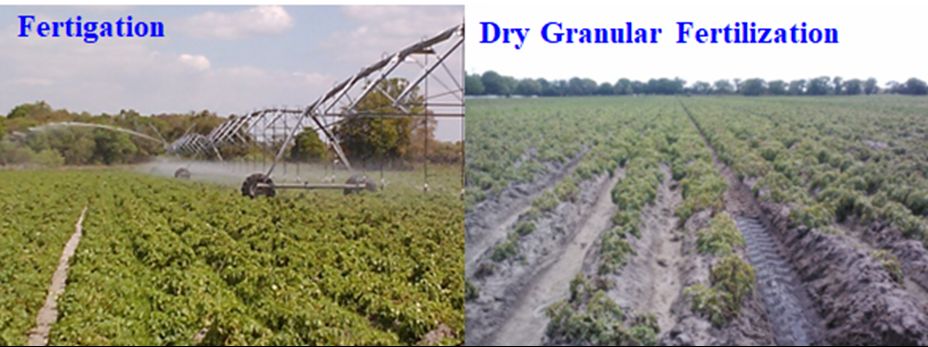Fertigation is an efficient method of nutrient application in which fertilizers are injected through an irrigation system. With promising results that suggest its ability to dramatically improve water- and nutrient-use efficiency, fertigation technology is gaining in popularity across the world (Thompson et al. 2018). When considering implementation of a fertigation system, it is important to weigh the advantages and disadvantages of fertigation construction. The purpose of this article is to outline some of the major benefits and drawbacks a fertigation system may incur. The audience of this article includes county Extension faculty, students who are interested in crop production, growers, certified crop advisors, crop consultants, environmentalists, and policy makers in the agricultural sector.
The Advantages of Fertigation
- Synchronizing nutrient supply and crop requirement
Synchronization of nutrient supply and crop demand enhances nutrient-use efficiency (Noordwijk 1990). Fertilization using granular fertilizers typically involves fertilizing once, twice, or three times during the growing season. For example, Florida strawberries with medium Mehlich-3 soil test results are recommended to be fertilized with 150 lb/A N, 100 lb/A P2O5, and 100 lb/A K2O. While these nutrients are often applied one or few times in a growing season using granular fertilization methods, they are applied daily at rates of 1.5–2.5 lb/A throughout the growing season using fertigation methods (Liu et al. 2021). When fertigating strawberry instead of fertilizing granularly, researchers found that strawberry fruit yield and plant biomass increased significantly (Singh et al. 2019). Fertigation is beneficial because nutrients are supplied uniformly to the root zone as they are required by the crop (Figure 1).

Credit: Mary Dixon and Guodong Liu, UF/IFAS
2. Greater crop yield
Applying nutrients with water has been shown to result in greater crop growth and yield in both fruit and vegetable crops when compared to traditional soil application methods of fertilizer (Sravani et al. 2020; Mohammad 2004). When growing squash at different rates of nitrogen (N) fertilization, shoot biomass and yield were observed to be greater when N was supplied through fertigation as opposed to granular fertilization (Mohammad 2004). This yield response varies with the crop grown. Crop yield has been shown to increase 40.3% for potato, 13.7% for fruit, 12.7% for maize, 11.7% for cotton, 7.6% for tobacco, and 6.0% for wheat when fertilizing with fertigation (Li et al. 2021). Crop yield, on average, has been shown to increase 12% compared to traditional fertilization practices (Li et al. 2021). This yield increase can largely be attributed to meeting crop nutrient requirements in a timely fashion. Figure 2 shows the difference in plant growth of potato with fertigation and dry granular fertilization.

Credit: Guodong Liu, UF/IFAS
3. Greater nitrogen-use and water-use efficiency
Fertilizing and irrigating crops through fertigation increases water- and N-use efficiency. Because nutrients are supplied through irrigation water, they are already in soluble forms available for plant uptake (Shirgure 2013). Soil nutrient concentration is managed within a small range in the root zone, and the nutrients applied to this zone are taken up with great efficiency (Ashrafi et al. 2020; Shirgure 2013). A recent meta-analysis has shown that without reducing crop yield, N input has been shown to decrease by 23% for maize, 26% for wheat, 33% for potato, 21% for tomato, and 23% for cotton when supplying N through fertigation (Li et al. 2021). This review similarly concluded that, compared to furrow irrigation, drip irrigation reduced water input by 14% for maize, 22% for wheat, 20% for potato, 20% for tomato, and 13% for cotton (Li et al. 2021).
4. Reduced labor time
Fertigation systems are often comprised of automated controls, resulting in a reduction of labor time. For example, the benefit-to-cost ratio of sugarcane growth was shown to increase using fertigation, in part because of reduced labor time (Rajendran et al. 2018). Decreasing the time of labor is valuable because split fertilizer applications using traditional fertilization methods may be costly. With fertigation, however, the labor cost associated with split fertilizer application is minimal (Xie et al. 2020). Especially in the late growth stages, the operation of farm equipment in the field may cause unintentional crop injury.
5. Reduced groundwater contamination
Fertigation has been shown to reduce both fertilizer input and nutrient leaching (Ashrafi et al. 2020). Compared to traditional granular fertilizer systems, fertigation uses less fertilizer. The frequent application of small quantities of nutrients is responsible for the greater nutrient-use efficiency observed in fertigation systems (Sureshkumar et al. 2017). Smaller quantities of nutrients are applied to the soil. Therefore, little is available for leaching under heavy rainfall events. Less leaching potential reduces the risk of groundwater contamination (Mohammad 2004; Thompson et al. 2018).
6. Suppressed weed pressure
Weed dry weight and population numbers were shown to be greater when crops were grown with conventional fertilization and furrow irrigation as compared to drip fertigation (Kakade et al 2019). Weeds used more nutrients in crop rows with furrow irrigation and conventional fertilization, whereas drip irrigation and fertigation provided reduced water and nutrient resources for weeds.
The Disadvantages of Fertigation
- High upfront cost
A considerable limitation in fertigation systems is the high cost associated with construction. Initial costs for fertigation typically include the purchase of tanks, injectors, backflow prevention valves, and timers (Mohd et al. 2016; Shirgure 2013). The efficacy of a fertigation system may vary depending on the type of injector or other equipment used (Kumar et al. 2012). High-cost corrosion-resistant materials are recommended (Shukla et al. 2018). These costs may be too high for growers to justify if the fertigation scale is too small (Shirgure 2013).
2. Requirement of consistent care
Any flaw in a fertigation system may lead to yield loss, inconsistent growth, and equipment damage (Shirgure 2013). Emitters must be maintained to apply uniform nutrition to crops (Shukla et al. 2018). There is potential of chemical backflow into the water source, so backflow prevention must be consistently addressed (Shukla et al. 2018). It is important to fully understand fertigation systems to fix and maintain the equipment. However, training growers and operators on fertigation systems may be costly or time consuming.
3. Clogging risks
The most common irrigation system for fertigation is drip irrigation (Fu et al. 2020), a system prone to clogging (Haman 1990; Thompson et al. 2018). It is recommended to use emitters designed to reduce clogging when possible. It is also important to use the right fertilizer and quality irrigation water (Liu and McAvoy 2018). To prevent precipitation and clogging, water-soluble fertilizers with near-neutral pH and a low salt index are needed (Sureshkumar et al. 2017). There is risk for precipitation in fertigation systems when using fertilizers with calcium or magnesium (Shukla et al. 2018; Sureshkumar et al. 2016). Growers and operators should ensure compatibility between fertilizers before use.
Conclusion
There are many benefits to implementing a fertigation system for crop production. Fertigation can synchronize nutrient supply and crop nutrient requirement, which enhances water-use efficiency, nutrient-use efficiency, and yield, while also reducing nutrient losses via leaching, ammonia volatilization, denitrification and weed pressure. Fertigation also significantly saves field trips and labor costs. However, it has drawbacks, including high initial investment cost and the need for constant maintenance. These costs should be considered. Dependent on the needs of the producer, advantages may outweigh the drawbacks, and hence, fertigation may be an effective tool for nutrient and water management best practices for crop production in Florida. Considering and addressing the disadvantages of fertigation may help in developing an effective fertigation system with great returns on investment to the grower.
References
Ashrafi, M. R., M. Raj, S. Shamin, K. Lal. and G. Kumar. 2020. “Effect of Fertigation on Crop Productivity and Nutrient Use Efficiency.” Journal of Pharmacognosy and Phytochemistry 9 (5): 2937–2942.
Fu, X., G. D. Liu, L. Zotarelli, S. Sargent, K. Migliaccio, and Y. C. Li. 2020. “How to Fertigate Plant Vines via Center Pivots for Commercial Potato Production in Florida.” EDIS 2020 (2). https://doi.org/10.32473/edis-hs1361-2020
Haman, D. Z. 1990. “Causes and Prevention of Emitter Plugging in Microirrigation Systems.” EDIS 2022 (1). https://edis.ifas.ufl.edu/ae032
Kakade, S. U., L. A. Mohurle, V. M. Bhale, and J. P. Deshmukh. 2019. “Effect of Drip Fertigation on Growth, Weed Dynamics, Yield and Economics of Pigeon Pea.” Journal of Agricultural Research and Technology 44 (1): 50–57.
Khan, M. F., and F. Mohammad. 2014. "Eutrophication: Challenges and Solutions." In Eutrophication: Causes, Consequences and Control, pp. 1–15. Springer, Dordrecht. https://doi.org/10.1007/978-94-007-7814-6_1
Kumar, M., T. B. S. Rajput, and N. Patel. 2012. "Effect of System Pressure and Solute Concentration on Fertilizer Injection Rate of a Venturi for Fertigation." Journal of Agricultural Engineering 49 (4): 9–13.
Li, H., X. Mei, J. Wang, F. Huang, W. Hao, and B. Li. 2021. “Drip Fertigation Significantly Increased Crop Yield, Water Productivity and Nitrogen Use Efficiency with Respect to Traditional Irrigation and Fertilization Practices: A Meta-analysis in China.” Agricultural Water Management 244:106534. https://doi.org/10.1016/j.agwat.2020.106534
Liu, G. D., and E. McAvoy. 2021. “How to Reduce Clogging Problems in Fertigation.” EDIS 2012 (7). https://doi.org/10.32473/edis-hs1202-2012
Liu, G. D., E. Simonne, K. Morgan, G. Hochmuth, S. Agehara, R. Mylavarapu, and P. Williams. 2021. “Fertilizer Management for Vegetable Production in Florida.” In Vegetable Production Handbook of Florida. EDIS 2021 (VPH). https://doi.org/10.32473/edis-cv296-2021
Mohd, Y. S., A. M. Arshad, N. F. Muhamad, and N. J. Sidek. 2016. “Potential and Viability of Chilli Cultivation Using Fertigation Technology in Malaysia.” International Journal of Innovation and Applied Sciences 17 (4): 1114–1119.
Van Noordwijk, M. 1990. “Synchronization of Supply and Demand Is Necessary to Increase Efficiency of Nutrient Use in Soilless Horticulture.” In Plant Nutrition — Physiology and Applications. Developments in Plant and Soil Sciences 41:525–531. Springer, Dordrecht. https://doi.org/10.1007/978-94-009-0585-6_87
Rajendran, M., and A. Irene. 2018. "Subsurface Drip Fertigation to Enhance Yield and Net Income of Sugarcane." In Engineering Interventions in Sustainable Trickle Irrigation: Irrigation Requirements and Uniformity, Fertigation, and Crop Performance, pp. 119–135. Oakville, Canada: Apple Academic Press Inc. https://doi.org/10.1201/9781315184241-8
Rusan, M. J. M. 2004. “Squash Yield, Nutrient Content and Soil Fertility Parameters in Response to Methods of Fertilizer Application and Rates of Nitrogen Fertigation.” Nutrient Cycling in Agroecosystems 68:99–108. https://doi.org/10.1023/B:FRES.0000019036.64212.9c
Shirgure, P. S. 2013. “Citrus Fertigation—A Technology of Water and Fertilizer Saving.” Scientific Journal of Crop Science 2(5): 56–66.
Shukla, M., A. C. Sadhu, A. R. Chinchmalatpure, I. Prasad, S. Kumar, and D. Camus. 2018. “Fertigation—Modern Technique of Fertilizer Application.” Indian Farmer 5 (9): 1062–1071.
Singh, S., N. P. Singh, R. Sharda, and A. K. Sangwan. 2019. “Response of Irrigation, Fertigation and Mulching on Plant Growth and Fruit Yield of Strawberry.” Indian Journal of Horticulture 76 (2): 233–240. https://doi.org/10.5958/0974-0112.2019.00036.7
Sravani, G. C., L. Singh, and M. Bakshi. 2020. “Performance Evaluation of Drip Irrigation (Fertigation) in Citrus Cultivation: A Review.” Journal of Pharmacosnosy and Phytochemistry 9 (5): 2557–2560.
Sureshkumar, P., P. Geetha, M. C. N. Kutty, C. N. Kutty, and T. Pradeepkumar. 2017. “Fertigation—The Key Component of Precision Farming.” Journal of Tropical Agriculture 54 (2): 103–114.
Thompson, R., I. Delcour, E. Berckmoes, and E. Stavridou. 2018. “Reducing Environmental Impact: Nutrient Removal and Recovery.” In The Fertigation Bible. FERTINNOWA and the European Union’s Horizon Research and Innovation Program.
Xie, X., T. Machikowa, and S. Wonprasaid. 2020. “Fertigation Based on a Nutrient Balance Model for Cassava Production in Two Different Textured Soils.” Plant Production Science 23 (4): 407–416. https://doi.org/10.1080/1343943X.2020.1743189
Zotarelli, L., P. J. Dittmar, P. D. Roberts, J. Desaeger, and B. Wells. 2021. “Chapter 14. Potato Production.” EDIS 2021 (VPH). https://doi.org/10.32473/edis-cv131-2021